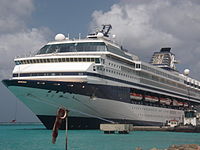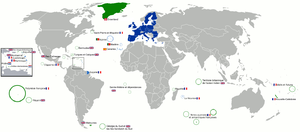- Economy of Aruba
-
The economy of Aruba is an open system, with tourism currently providing the largest percentage of the country's income. Because of tourism's rapid growth in the last 80 years, related industries like construction have also flourished. Other primary industries include oil refining and storage, as well as offshore banking. Although the island's poor soil and low rainfall limit its agricultural prospects, aloe cultivation, livestock, and fishing contribute to Aruba's economy. In addition, the country also exports art and collectibles, machinery, electrical equipment, and transport equipment. Aruba's small labor force and low unemployment rate have led to a large number of unfilled job vacancies, despite sharp rises in wage rates in recent years.
With such a large part of its economy dependent on tourism, the Aruban government is striving[citation needed] to increase business in other sectors to protect against possible industry slumps. Their current focus is on expanding technology, finance, and communications.
Contents
History
Unlike many Caribbean islands, a plantation economy never developed on Aruba due to its arid climate. Early Spanish explorers considered the island of little value, partly because the poor soil made growing crops difficult and partly because their attempts to find gold turned up empty-handed. However, long after the Dutch obtained control of Aruba, they found the gold the Spanish had been seeking.
Gold
With the discovery of gold on Aruba in 1800, mining became the island's foremost industry. Aruba's economy boomed. However, by 1916 the gold supply had mostly been tapped out, making it impossible for companies to turn a profit. As the gold mining industry waned, so did the economy.
Aloe
First planted on Aruba in 1850, aloes throve in its desert conditions. With a healthy demand for aloe products, it became an important part of Aruba's economy. In fact, for many years, the country was aloe's top exporter. But over the years, many aloe fields were replaced by buildings, diminishing its production and exports declined.
The oldest company on the island, Aruba Aloe, has recently instituted changes in the hopes of becoming Aruba's leading product manufacturer. It built a new, modern facility, an aloe museum, and designed new packaging. Although most of their product line sells in the national market, a 2005 exporting deal with a U.S. company and sales through their website have increased their international market.
Oil
Despite setbacks caused by the troubled gold and aloe industries, Aruba's economy didn't suffer long. Because of its location near Venezuela, the island became an attractive spot for oil refineries. The Lago Oil and Transport Company, owned by Exxon, opened in 1929. At the time, Lago's oil refinery and storage facility was the largest in the world. Following in their footsteps, the Eagle Oil Refinery opened soon after. Over the next few decades, the oil industry took over as Aruba's primary economic force.
The Eagle Oil Refinery shut down and was dismantled in the late 1950s. But the Lago refinery kept going until 1985, when the demand for oil fell and Exxon closed it. In 1991, the Coastal Oil Company bought it, scaled down operations, and reopened it. Although its reopening didn't raise Aruba's oil industry to its previous heights, it did revive that sector and continues to be a key contributor to the country's economy.
Tourism
The Celebrity Mercury cruise ship docked in Oranjestad.
In 1947, Aruba's government founded a tourist board to explore the possibility of developing a tourism industry. Several years later, cruise ships began to dock in Oranjestad, Aruba's capital city. The island's first luxury hotel was built in 1959, giving the fledgling industry a good start. Over the years, tourism grew and helped create a prosperous economy.
As the oil industry waned, tourism increased in importance. The government offered fiscal incentives to spur growth of hotels and other tourist-oriented businesses. Their efforts resulted in a steady and rapid rise in tourism. When a surplus of these jobs couldn't be filled, they placed a one-year moratorium on new hotel construction and new tourist corporations.
Following the terrorist attacks of Sept. 11, 2001, tourism temporarily declined because of grounded flights and travel fears. Aruba stepped up its visible security force in tourist areas to heighten safety and reassure visitors. After a short time, tourism rebounded strongly.
Another potential threat to the industry occurred in 2005, when the May 30 disappearance of vacationing Alabama teen Natalee Holloway made international news. Claiming that Aruban authorities weren't taking the case seriously enough, her mother and the Governor of Alabama called for a nationwide boycott of Aruba. However, the U.S. federal government didn't back the proposed boycott. Aruba's reputation as one of the safest islands in the Caribbean may have helped it overcome any negative stigma caused by the case. The amount of tourism in June, 2005, actually rose by 9% from the previous year.
Statistics
GDP: purchasing power parity - $2.400 billion (2007 est.)
GDP - real growth rate: 1.0% (2007 est.)
GDP - per capita: purchasing power parity - $21,500 (2007 est.)
GDP - composition by sector: agriculture: 0.4% industry: 33.3% services: 66.3% (2002 est.)
Inflation rate (consumer prices): 8.7% (2007)
Labor force: 41,500 (2004 est.)
Unemployment rate: 6.9% (2005 est.)
country comparison to the world: 86Budget: revenues: $507.9 million
expenditures: $577.9 million (2005 est.)
Public debt: 46.3% of GDP
country comparison to the world: 43Central bank discount rate: 5% (2008)
country comparison to the world: 80Industries: tourism, transshipment facilities, oil refining
Agriculture - products: aloes; livestock; fish
Electricity - production: 800 million kWh (2006 est.)
country comparison to the world: 151Electricity - consumption: 744 million kWh (2006 est.)
country comparison to the world: 149Electricity - exports: 0 kWh (2007)
Electricity - imports: 0 kWh (2007)
Oil - production: 2,356 bbl/d (374.6 m3/d) (2007)
country comparison to the world: 100Oil - consumption: 7,102 bbl/d (1,129.1 m3/d) (2006 est.)
country comparison to the world: 155Oil - exports: 233,300 bbl/d (37,090 m3/d) (2005)
country comparison to the world: 49Oil - imports: 238,200 bbl/d (37,870 m3/d) (2005)
country comparison to the world: 41Oil - proved reserves: n/a
Natural gas - production: 0 cu m (2007 est.)
country comparison to the world: 93Natural gas - consumption: 0 cu m (2007 est.)
country comparison to the world: 112Natural gas - exports: 0 cu m (2007 est.)
country comparison to the world: 40Natural gas - imports: 0 cu m (2007)
country comparison to the world: 61Natural gas - proved reserves: 0 cu m (1 January 2006)
country comparison to the world: 104Exports: $124 million f.o.b.; note - includes oil reexports (2006)
country comparison to the world: 192Exports - commodities: live animals and animal products, art and collectibles, machinery and electrical equipment, transport equipment
Exports - partners: Panama 29.7%, Colombia 17%, Netherlands Antilles 13.2%, US 11.3%, Venezuela 10.9%, Netherlands 9.2% (2007)
Imports: $1.054 billion f.o.b. (2006)
country comparison to the world: 171Imports - commodities:machinery and electrical equipment, crude oil for refining and reexport, chemicals; foodstuffs
Imports - partners: US 54.6%, Netherlands 12%, UK 4.7% (2007)
Debt - external: $478.6 million (2005 est.)
country comparison to the world: 165Economic aid - recipient: $11.3 million (2004)
Currency: Aruban guilder/florin
Exchange rates: Aruban guilders/florins per US dollar - NA (2007), 1.79 (2006), 1.79 (2005), 1.79 (2004), 1.79 (2003)
Fiscal year: calendar year
References
Aruba topics Politics and government Coast guard · Coat of arms · Constitution · Elections · Estates (parliament) · Flag · Foreign relations · Governor · Military · Monarch · Police · Political parties · Prime Minister · Visa policyCulture and history Economy and infrastructure Geography and environment Sports See also: Index of Aruba-related articles, Outline of Aruba, Kingdom of the Netherlands, Netherlands AntillesEconomy of South America Sovereign states Dependencies and
other territories- Aruba
- Bonaire
- Curaçao
- Falkland Islands
- French Guiana
- Economy of the Caribbean
- Anguilla
- Antigua and Barbuda
- Aruba
- Bahamas
- Barbados
- Bonaire
- British Virgin Islands
- Cayman Islands
- Cuba
- Curaçao
- Dominica
- Dominican Republic
- Grenada
- Guadeloupe
- Haiti
- Jamaica
- Martinique
- Montserrat
- Puerto Rico
- Saba
- Saint Barthélemy
- Saint Kitts and Nevis
- Saint Lucia
- Saint Martin
- Saint Vincent and the Grenadines
- Sint Eustatius
- Sint Maarten
- Trinidad and Tobago
- Turks and Caicos Islands
- U.S. Virgin Islands
Economies of the dependencies of European Union states 
Denmark France French Polynesia • Mayotte • New Caledonia • Saint Barthélemy • Saint Martin • Saint Pierre and Miquelon • Wallis and Futuna •
Netherlands Aruba • Curaçao • Sint Maarten
United Kingdom Crown dependencies: Guernsey • Isle of Man • Jersey
Overseas territories: Anguilla • Bermuda • British Virgin Islands • Cayman Islands • Falkland Islands • Gibraltar • Montserrat • Pitcairn Islands • Saint Helena • South Georgia and the South Sandwich Islands • Turks and Caicos Islands •
Categories:
Wikimedia Foundation. 2010.


